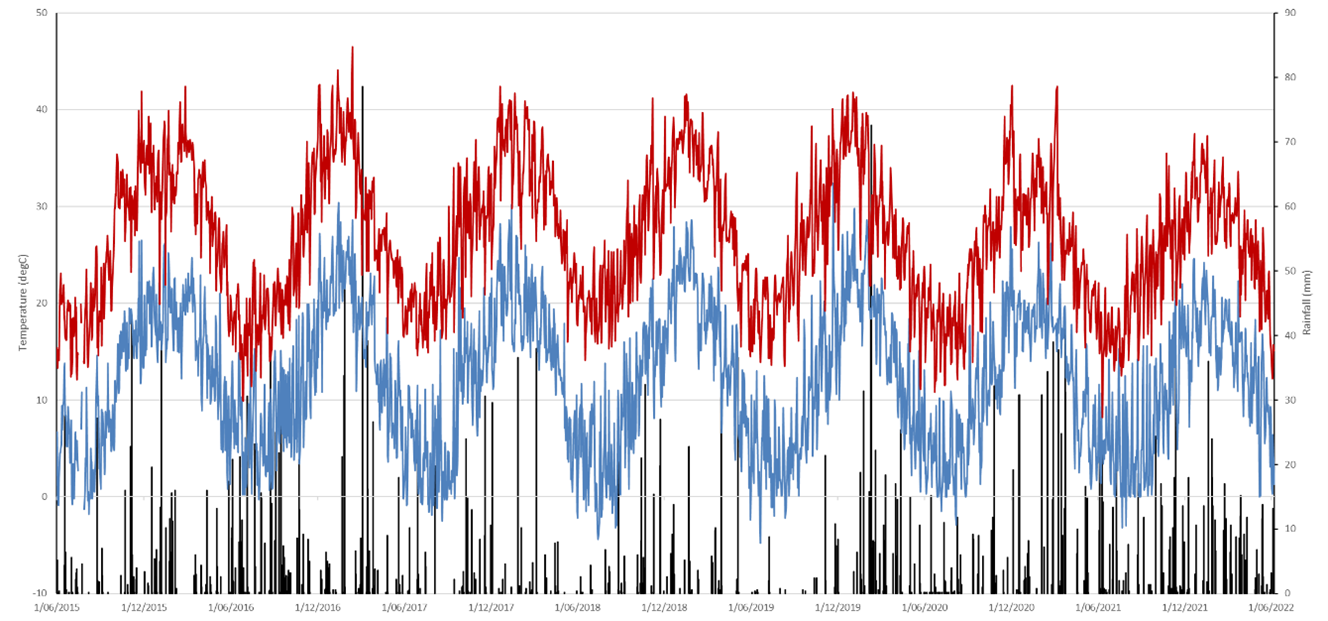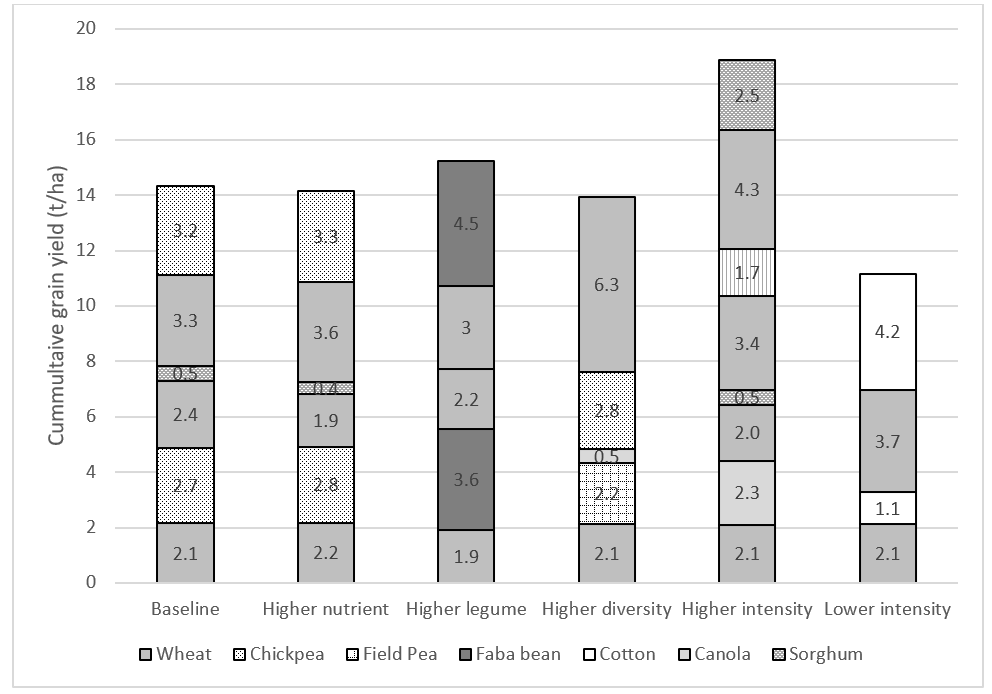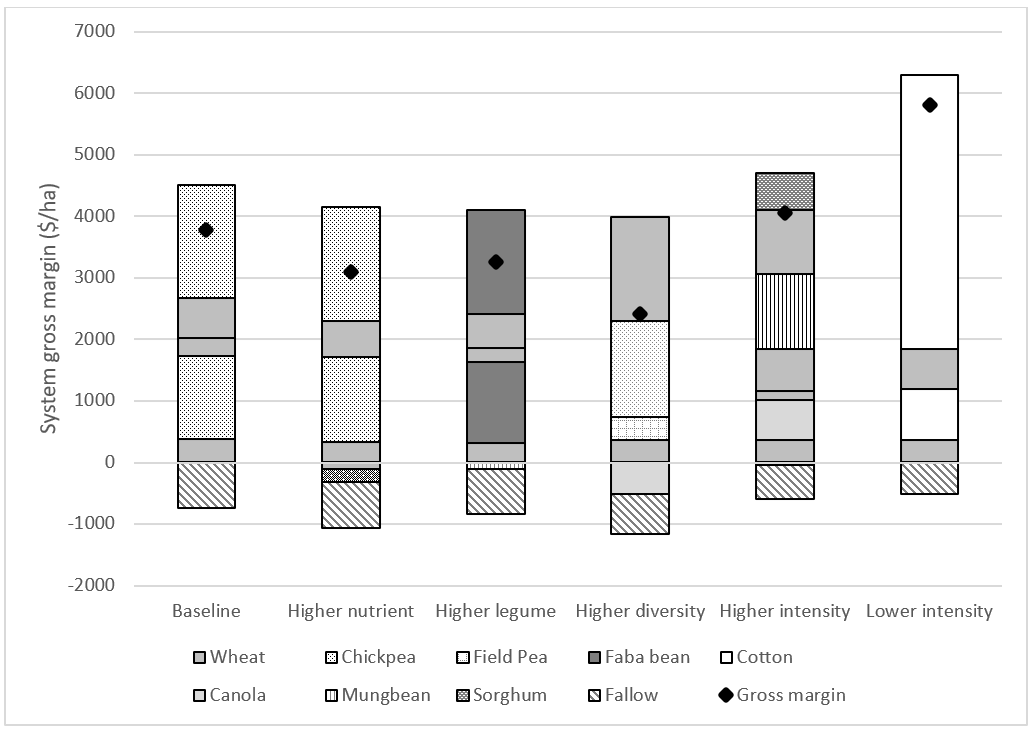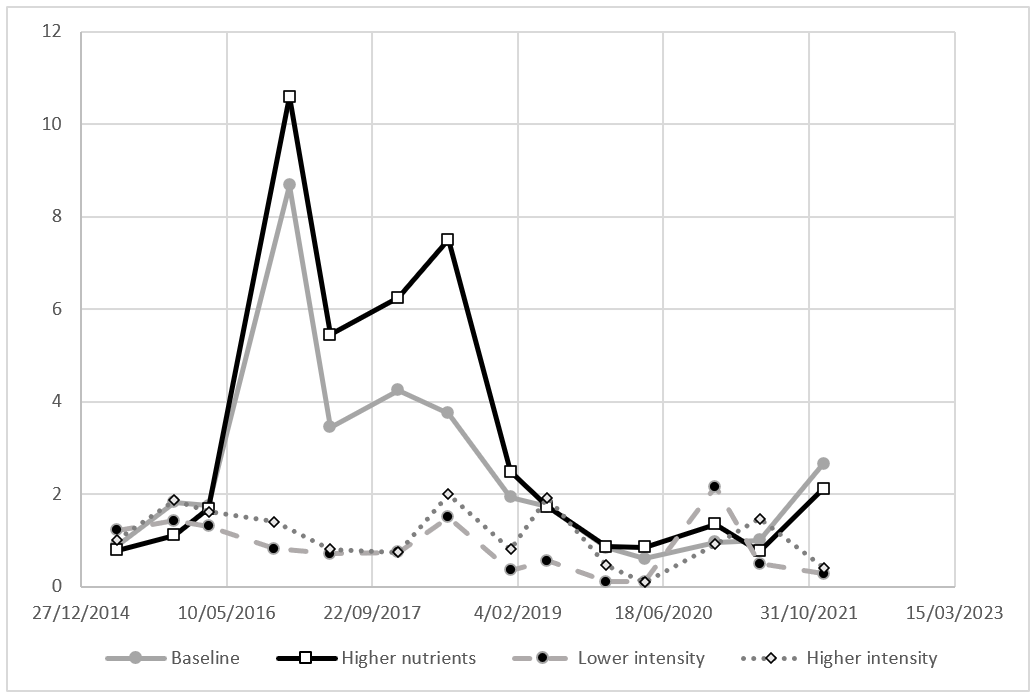Farming system modifications at Narrabri - legacy impacts on grain productivity economics, and soil dynamics
Author: Jon Baird (NSW Department of Primary Industries) | Date: 20 Jul 2022
Take home message
- Intensifying the cropping frequency increased system grain productivity compared to the base-line grower’s practice/sequence. The Higher intensity system which grew nine crops produced 4.0 t/ha more than the baseline system which grew six crops
- The increased grain productivity of the Higher intensity system led to higher fertiliser usage and greater drawdown on residual soil nutrient reserves (in particular mineral N)
- Increasing fallow length to improve planting moisture resulted in lower system grain productivity but higher individual crop yields, leading to the highest system gross margin as high value crops (such as cotton) maximised yield potentials
- Sequencing wheat-chickpea elevated soil populations of the root lesion nematode Pratylenchus thornei, to the extent where cultivars that are highly susceptible to this nematode species had to be replaced by more resistant options.
Introduction
While advances in agronomy and the performance of individual crops have helped grain growers to maintain their profitability, current farming systems are underperforming; with only 30% of crop sequences in the northern grains region achieving 75% of their water limited yield potential.
Growers face challenges from declining soil fertility, increasing herbicide resistance, and increasing soil-borne pathogens in their farming systems. Change is needed to meet these challenges and to maintain farming system productivity and profitability. Consequently, Queensland Department of Agriculture and Fisheries (DAF), New South Wales Department of Primary Industries (NSW DPI) and Commonwealth Scientific and Industrial Research Organisation (CSIRO) are collaborating to conduct an extensive field-based research program, focused on developing farming systems to better use the available rainfall to increase productivity and profitability, with the question;
“Can systems performance be improved by modifying farming systems in the northern region?”
In 2014 research began in consultation with local growers and agronomists to identify the key limitations, consequences and economic drivers of farming systems in the northern region; to assess farming systems and crop sequences that can meet the emerging challenges; and to develop the systems with the most potential for use across the northern region.
Experiments were established at seven locations; with a large factorial experiment managed by CSIRO at Pampas near Toowoomba, and locally relevant systems being studied at six regional centres by DAF and the DPI NSW (Emerald, Billa Billa, Mungindi, Spring Ridge, Narrabri and Trangie (red & grey soils)).
Table 1. Systems implemented at each of the locations. Trangie has systems applied on both red and grey soils. Pampas includes summer dominant, winter only and mixed opportunity cropping systems. Pampas also includes combinations (i.e., higher legume + diversity) not listed here.
Pampas (Core site) | Regional sites | ||||||||||||
|---|---|---|---|---|---|---|---|---|---|---|---|---|---|
System/ modification | Summer | Winter | Mixed | Emerald | Billa Billa | Mungindi | Spring Ridge | Narrabri | Trangie | ||||
Baseline | * | * | * | * | * | * | * | * | * | ||||
Higher crop intensity | * | * | * | * | * | * | |||||||
Lower crop intensity | * | * | * | * | ** | * | * | * | |||||
Higher legume frequency | * | * | * | * | * | * | * | * | * | ||||
Diverse crop options | * | * | * | * | * | * | * | * | |||||
Higher nutrient supply | * | * | * | ** | ** | * | * | * | * | ||||
No. of systems | 38 | 6 | 9 | 6 | 6 | 6 | 6 | ||||||
Farming system descriptions
- Baseline is typical of local zero tillage farming systems with approximately 1 crop per year grown using moderate planting moisture triggers of 50% plant available water capacity (PAWC). Crops grown in this system are limited to wheat/barley, chickpea and sorghum. These crops have nitrogen fertiliser applied to achieve 50th yield percentile as determined by the PAW prior to planting and based on APSIM yield simulations for each site.
- Lower crop intensity reflects a conservative rotation to accumulate greater PAW for the next crop (80% PAWC). The same nutrient management as the baseline system is applied. Crops grown are also similar to the baseline but may also include cotton as a high value crop at some sites.
- Higher crop diversity allows a greater suite of crops to be grown to better manage disease, root lesion nematodes and herbicide resistance. Planting triggers and nutrition are the same as the baseline system. The unique rules for this system focus on managing root lesion nematodes, with 50% of the selected crops to be resistant to Pratylenchus thornei, and 1 in 4 crops resistant to Pratylenchus neglectus. To manageherbicide resistance, two crops utilising the same herbicide mode-of-action cannot follow each other. Crops grown in this system include wheat/barley, chickpea, faba bean, field pea, canola/mustard, sorghum, mungbean, maize, millet and sunflower.
- Higher legume aims to minimise the use of nitrogen fertiliser by growing every second crop as a pulse (legume), with a preference for those that produce greater biomass and greater carry-over nitrogen benefits. Crops grown in this system are similar to the baseline (wheat/barley, chickpea, sorghum) with additional pulse options (faba bean, field pea, & mungbean). Crops will be fertilised (N) to achieve average yield potential for the PAW, with nitrogen only applied to the cereal crops.
- Higher crop intensity aims to minimise the fallow periods within the system and potentially grow 3 crops every 2 years. Crops will be planted on lower PAW (30%) and have a greater reliance on in-crop rainfall. Crop choice is the same as the baseline system, but with mungbean added as a short double-crop option. These crops are fertilised (N) to achieve average seasonal yield potential for the PAW prior to planting.
- Higher nutrient supply will have N and P fertiliser applied to match the fertiliser requirements of a 90th yield percentile crop; with the risk that crops will be over fertilised in some drier years. This system will be planted to the same crop as the baseline each year, so that the only difference is the amount of nutrients applied.
Method
Field experimental location
The Narrabri farming systems site is located on the University of Sydney’s research farm – “Llara”. The soil at the site is a brown-grey Vertosol with medium-heavy clay throughout the soil profile (Table 2). The site has high background fertility levels. The PAWC calculated at the site is 210 mm for wheat to a depth of 120 cm.
Table 2. Soil characteristics at Narrabri “Llara” field site.
Depth | Organic carbon | Conductivity | pH | |
|---|---|---|---|---|
(cm) | (%) | (dS/m) | (CaCl2) | (H2O) |
0-15 | 0.83 | 0.10 | 7.47 | 7.96 |
15-30 | 0.55 | 0.20 | 8.10 | 8.86 |
30-60 | 0.48 | 0.28 | 8.29 | 9.20 |
60-90 | 0.39 | 0.35 | 8.56 | 9.52 |
90-120 | 0.30 | 0.43 | 8.59 | 9.49 |
System evaluation
Over the course of the project life for each system at each experimental site, data was collected on crop yield, input costs including fertilisers, seed, herbicides, pesticides and machinery operations. This allowed calculation of the accumulated income and gross margins for each of the cropping systems deployed at every location. Consistent prices for each commodity (10-year average adjusted for inflation) were used to avoid introducing discrepancies in the data (Table 3). All grain yields were corrected to 12% moisture to account for variable harvest moistures.
Table 3. Grain pricing used in calculations based on median prices over the past ten years, less $40/t cartage costs, for selected crops.
Crop | $/t | Crop | $/t |
|---|---|---|---|
Barley | 218 | Sorghum | 221 |
Wheat (durum and APH) | 269 | Maize | 281 |
Canola | 503 | Mungbean | 667 |
Chickpea | 504 | Sunflower | 700 |
Faba bean | 382 | Cotton | 1090 ($480/bale lint) |
Field pea | 335 |
Experimental conditions
The climatic conditions experienced during the project were quite variable (Figure 1). The site experience drought conditions from December 2017 to December 2019, and then received higher than average rainfall for the 2020 and 2021 calendar years (703 and 772 mm). In addition, maximum temperatures during the 2016/17 and 2017/18 summers were quite high and resulted in crop stress in summer crops such as sorghum.

Figure 1. Climatic conditions at Narrabri (2015-2022). The red line denotes daily maximum temperature, blue line is the daily minimum temperature and black columns show daily rainfall.
System rotation
There was a wide divergence in cropping sequences at the Narrabri farming systems site as treatment rules dictated various cropping scenarios (Table 4). The Baseline system – which mimics a ‘typical’ grower’s practice - was dominated with wheat, chickpea and sorghum. The Higher legume system sowed crops in similar seasons to the Baseline, but contained an extra legume crop compared to the Baseline and two fababean crops in the rotation instead of the chickpea in Baseline system. The higher diversity system as expected sowed a wider range of crops including fieldpea, canola, durum wheat, bread wheat and chickpea.
The biggest variation in crop selection and timing was between the Higher and Lower intensity systems. With the Higher intensity containing nine planted crops compared to the Lower intensity which planted four harvested crops and one cover crop. This included the 2021/22 summer season with both systems growing either cotton (Lower intensity) or sorghum (Higher intensity) (Table 4).
Table 4. Farming system cropping sequence at Narrabri (2015-2022).
Baseline | Higher nutrient | Higher legume | Higher diversity | Higher intensity | Lower intensity | |
|---|---|---|---|---|---|---|
Winter 15 | Wheat | Wheat | Wheat | Wheat | Wheat | Wheat |
Summer 15 | ||||||
Winter 16 | Chickpea | Chickpea | Faba bean | Field Pea | Canola | |
Summer 16 | Cotton | |||||
Winter 17 | Wheat | Wheat | Wheat | Canola | Wheat | |
Summer 17 | ||||||
Winter 18 | ||||||
Summer 18 | Sorghum | Sorghum | Mungbean | Sorghum | ||
Winter 19 | Durum | Chickpea | ||||
Summer 19 | ||||||
Winter 20 | Wheat | Wheat | Wheat | Chickpea | Wheat | Wheat |
Summer 20 | Mungbean | |||||
Winter 21 | Chickpea | Chickpea | Fababean | Wheat | Wheat | |
Summer 21 | Sorghum | Cotton |
Project results
System yield
Of the six farming systems at Narrabri, the Higher intensity system had the greatest productivity at 18.5 t/ha (Figure 2). It has produced more than 3 t/ha of grain than the next system (Higher legume – 15.2 t/ha). The higher grain productivity is related to the increase in crop intensity since winter 2021, as the Higher intensity system grew twice as many crops as the other systems during that period (four compared to two or one). The higher cumulative grain production did come at an expense to individual crop yield, as the system did have lower individual season yields compared to the other systems which had longer fallow periods. For instance, the 2021 wheat in the Higher intensity system which followed a summer mung bean crop was lower yielding (4.3 t/ha) than the 2021 wheat crop in the Higher diversity (6.3 t/ha) which had a summer fallow following chickpeas in winter 2020.
Further highlighting the influence cropping intensity has on grain productivity, the Lower intensity system had the lowest cumulative grain yield at Narrabri (11.0 t/ha) (Figure 3).
Figure 2. Cumulative farming system grain production at Narrabri, NSW (2015-2022).
System economics
The gross margins for each of the farming systems at Narrabri increased considerably during the last three seasons (Figure 3). The largest improvement coming from the Lower intensity system with a gross margin of $5,801/ha, as the 2021/22 cotton crop achieved the highest returns to date in the project. The Lower intensity system went from being one of the lowest gross margins to the highest due to the returns from the high value 2021/22 cotton crop ($4,455/ha). This system was historically safe in terms of crop returns as there were no failed crops recorded at Narrabri, compared to the other systems which had at least one failed crop (the one crop with negative income in the Lower intensity was a designated sown cover crop).
Of the other systems, the Higher intensity did have the greatest crop income due to the extra sown crops, but growing costs were also highest and therefore overall systems gross margin ($4,049/ha) tracks similar to the Baseline system ($3,775/ha).
The additional fertiliser applied to the Higher nutrient system reduced the overall system gross margin compared to the Baseline system (-$680) (Figure 3). Crop yields from the project showed that water availability had a greater influence on productivity rather than nutrient application, and therefore the higher nutrient system struggled to generate extra yield or income with the higher fertiliser application rates.
Figure 3. System gross margins and crop returns at Narrabri (2015-2022).
System water use
The Higher legume system had the greatest water use efficiency (WUE) with 6.3 kg/mm/ha at Narrabri between 2015 and 2021 (Table 5). This corresponded with the high grain productivity from the two planted fababean crops (2016 and 2021), highlighting that incorporating legumes into a farming system can improve grain yields and maintain good WUE. Although, one implication of incorporating legumes into the farming systems is the high degradation of plant residue which influences ground cover and thus fallow efficiency. This was evident at Narrabri, as the Higher legume system had a fallow efficiency of 28%, well below the efficiency of the Baseline system (32%).
Both the Higher intensity and Higher diversity systems had similar WUE (5.9 mm/kg/ha), but had contrasting fallow efficiency, as the shorter fallows in the Higher intensity resulted in the highest fallow efficiency at Narrabri at 33%. The Higher diversity system with longer fallow periods (second only to the Lower intensity system) had a fallow efficiency of 28% (Figure 5).
System WUE ($/mm) was highest in the Lower intensity, as the high system returns improved the efficiency compared to the Baseline system by 84%, and by 174% to the Higher diversity system which had the lowest system gross margin at Narrabri.
Table 5. System water use efficiency (WUE as kg grain/mm PAW), fallow efficiency (FE is % of fallow rainfall captured and stored) and System WUE ($/mm is the system gross margin/mm rainfall)
System | WUE (kg/mm/ha) | FE (%) | $/mm |
|---|---|---|---|
Baseline | 5.5 | 32 | 0.96 |
Higher nutrient | 5.5 | 29 | 0.78 |
Higher legume | 6.3 | 28 | 0.83 |
Higher diversity | 5.9 | 28 | 0.62 |
Higher intensity | 5.9 | 33 | 1.01 |
Lower intensity | 5.2 | 14 | 1.7 |
Nutritional legacy
The project monitored the legacy impact cropping system had through two process, collecting soil analysis pre- and post- crop and via crop export (system export = seed nutrient % multiplied by grain dry weight).
There were two modified systems that resulted in an increase to the application rate of nitrogen (N) fertiliser – Higher nutrient and Higher intensity – compared to the Baseline system. Both systems increased the fertiliser N rates more than 200 kg N/ha over the Baseline system, but only the Higher intensity exported more N from the system (+25 kg N/ha), while the Higher nutrient system had similar export rates to the Baseline system (Table 6).
The value of increasing legumes in the cropping system did influence nutrition dynamics as the Higher legume system had the same amount of N fertiliser applied as the Baseline system, but overall system balance was far greater as there was an extra 114 kg N/ha exported in grain, along with higher phosphorus and potassium levels. These results highlight that although fertiliser use was not reduced, the nutrient dynamics of the farming system can be improved with the introduction of legume crops.
Table 6. Farming system application and export rates of macro-nutrients at Narrabri.
System | Applied nitrogen fertiliser | Exported nitrogen | Mineral nitrogen change 2015-2021 | Exported phosphorus | Exported potassium |
|---|---|---|---|---|---|
Baseline | 207 | 345 | -99 | 47 | 81 |
Higher nutrient | 448 | 345 | -52 | 47 | 84 |
Higher legume | 208 | 469 | -77 | 60 | 110 |
Higher diversity | 223 | 352 | -87 | 44 | 75 |
Higher intensity | 462 | 370 | -93* | 64 | 79 |
Lower intensity | 158 | 189 | 41* | 47 | 32 |
*does not include summer 2021/22 harvest results
Disease/pathogen legacy
PreDicta B® testing for pathogen levels, including Pratylenchus thornei (Pt) occurred biannually, pre and post every crop. At Narrabri, Pt numbers indicated a strong association with farming system treatments based on the individual crops and varieties grown (Figure 4). The crop choice in 2016 had a large effect on Pt numbers. Chickpea planted in the Baseline and Higher nutrient systems increased Pt numbers by up to five times over the 2016 pre-sowing numbers. The other legumes planted in 2016, field pea in the higher diversity plots and faba bean in the higher legume system, also increased Pt numbers, but not to the same extent as with chickpea. Although Pt numbers did increase to moderate levels in 2016 within the baseline and higher nutrient systems, there was no yield effect – chickpea yields for both systems were 2.7 t/ha.
P. thornei numbers reduced across all six systems during the 2016–17 summer fallow. Numbers in both the baseline and higher nutrient systems increased slightly during the 2017 wheat crop (LRPB Lancer) which is rated moderately susceptible (MS) to Pt. As a result, both these systems had more than three times the Pt numbers than the other four farming systems by the end of 2017. Conversely, in the other four farming system treatments, Pt numbers reduced during 2017 with levels less than 1.3 Pt/g soil by the end of 2017 (Figure 4). With drought-like conditions starting in the winter of 2018, Pt soil populations declined across all treatments and remained in the low population category until the end of the first phase of the project (May 2020).
Figure 4. Root lesion nematode Pratylenchus thornei numbers at Narrabri across treatments and seasons.
Conclusion
Results from this site demonstrate that growers within the North-west region can modify their current farming systems to achieve greater grain production and/or higher gross margins. This is in part related to modifying planting triggers, as increased cropping frequency with lower soil moisture planting triggers (30% PAW) did improve grain and dry matter production, compared to a moderate planting trigger (50% PAW). In contrast, an even higher planting trigger (80% PAW) led to fewer crops sown during the project life, but the planted crops achieved high yield potential and higher crop value which resulted in greater system gross margin. This means that growers can utilise long fallows to accumulate soil moisture and use that moisture to produce high individual crop yields and better economic results. However, this approach appeared to be very sensitive to using high value crop species (e.g., cotton) to capture the benefit of increased PAW at sowing.
There were legacy implications with increasing the cropping intensity as it led to higher fertiliser use to compensate for increased biomass production and higher grain yield. Although applied fertiliser was greater in the high intensity system, there was still a reduction in background nutrients to a larger degree than the other systems. This in turn may require increased input costs with this farming system to avoid crop yield potential becoming restricted by nutrient deficiencies.
Acknowledgements
The research undertaken as part of this project is made possible by the significant contributions of growers through both trial cooperation and the support of the GRDC, the author would like to thank them for their continued support.
Contact details
Jon Baird
NSW Department of Primary Industries
ACRI, 21888 Kamilaroi Hwy, Narrabri
Ph: 0429 136 581
Email: jon.baird@dpi.nsw.gov.au
® Registered Trademark
GRDC Project Code: CSP1406-007RTX, DAQ1406-003RTX,
Was this page helpful?
YOUR FEEDBACK




